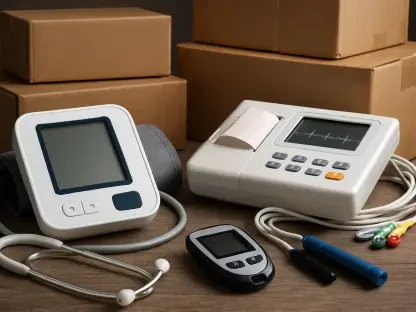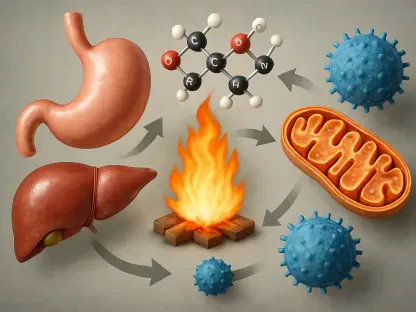The landscape of American healthcare is facing a significant shakeup with the recent announcement of a US-EU trade agreement that introduces a 15 percent tariff on branded pharmaceuticals imported from Europe, raising alarms for millions of patients who depend on critical medications. This policy, affecting high-demand drugs such as Ozempic and Wegovy, could lead to a noticeable spike in costs for treatments addressing chronic conditions like diabetes, cancer, and cardiovascular issues. As generic drugs and active pharmaceutical ingredients remain exempt, the burden falls squarely on branded medications, many of which lack affordable alternatives due to patent protections. The potential for higher retail prices, increased insurance premiums, or elevated co-pays has sparked concern among healthcare advocates and patients alike. This development not only challenges individual budgets but also underscores deeper systemic issues in drug affordability, setting the stage for a broader debate on trade policies and their impact on access to essential care in the United States.
Understanding the US-EU Trade Agreement
Tariff Details and Affected Medications
The newly implemented US-EU trade agreement has introduced a substantial 15 percent tariff on branded pharmaceuticals imported from European countries, directly targeting a wide array of essential medications. Drugs such as Ozempic and Wegovy, manufactured by Novo Nordisk in Denmark, stand out as prominent examples, alongside other critical treatments produced by companies like Eli Lilly in Ireland and Sanofi in France and Germany. These medications span therapeutic areas including diabetes management, weight loss, oncology, and respiratory care, affecting a significant portion of American patients. With many of these drugs under patent protection, the lack of generic alternatives means that patients have little choice but to absorb the potential cost increases. This tariff structure, while bypassing generics, places a heavy financial burden on branded products, prompting questions about how manufacturers will respond and whether the costs will ultimately trickle down to consumers through various channels in the healthcare system.
Beyond the specific drugs impacted, the scope of this tariff policy reveals a broader challenge for the pharmaceutical supply chain between the US and Europe, highlighting significant implications for both markets. The agreement focuses solely on finished branded products, leaving raw materials and generics untouched, which suggests a targeted approach to influence market dynamics for high-value medications. This could alter the competitive landscape, as European manufacturers may face pressure to adjust pricing strategies or shift production to mitigate tariff costs. For American patients, particularly those reliant on specialized treatments with no immediate substitutes, the implications are stark. The potential for disrupted access or escalating expenses looms large, especially for therapies that address life-threatening or chronic conditions. As this policy unfolds, its effects on drug availability and patient care will likely become a focal point for healthcare stakeholders seeking to balance trade objectives with the urgent needs of the population.
Scope and Strategic Implications
A deeper look into the US-EU trade agreement reveals that its tariff imposition is not merely a financial measure but also a strategic maneuver within global trade dynamics. By focusing on branded pharmaceuticals, the policy aims to address domestic concerns while reshaping economic relationships with European partners. Medications for complex conditions, including cancer therapies and cardiovascular treatments, are among those hit hardest, reflecting the high stakes for patients who rely on cutting-edge innovation. This selective tariff approach may push pharmaceutical giants to reconsider their manufacturing footprints, potentially incentivizing more localized production in the US to avoid import costs. However, such shifts are neither immediate nor guaranteed, leaving a gap where patients could face sustained price pressures in the interim. The broader intent behind this policy appears to prioritize national economic interests, yet its immediate fallout raises critical questions about equity in healthcare access.
Furthermore, the strategic implications of this tariff extend to the innovation pipeline within the pharmaceutical sector, where Europe plays a pivotal role in research and development. Many branded drugs originate from European labs, and the added costs could influence how companies allocate resources for future drug development. For American patients, this might translate into delayed access to novel treatments if manufacturers pass on tariff burdens or scale back investment due to reduced profitability. Meanwhile, the policy’s focus on branded products rather than generics underscores a tension between protecting domestic markets and maintaining a global supply chain that benefits consumers through competition. As this trade measure takes effect, its ripple effects could redefine partnerships between US and European entities, with patient affordability caught in the crossfire of these larger geopolitical and economic strategies.
Controversy and Legal Challenges
National Security Justification and International Pushback
At the heart of the controversy surrounding the US-EU trade agreement lies the US justification for imposing a 15 percent tariff on branded pharmaceuticals, rooted in national security concerns. This rationale, stemming from past administrative priorities, posits that reliance on foreign drug supplies could pose risks to domestic health stability, prompting the need for protective measures. However, this stance has met with sharp criticism from EU negotiators who argue that it undermines long-standing commitments under the World Trade Organization’s agreements, which historically exempt pharmaceuticals from such tariffs. The resulting friction highlights a clash between unilateral policy decisions and multilateral trade norms, casting uncertainty over future negotiations. For American patients, this dispute adds another layer of complexity, as the resolution—or lack thereof—could dictate the trajectory of drug pricing and availability in the near term.
The international pushback against the tariff policy extends beyond mere rhetoric, with potential ramifications for broader trade relations between the US and EU. European leaders have signaled their intent to challenge the measure through formal channels, possibly escalating tensions at a time when global cooperation on healthcare remains critical. This legal battle raises significant questions about the precedent it sets for other industries and whether exemptions for pharmaceuticals will hold in future trade frameworks. Meanwhile, the invocation of national security as a basis for tariffs has drawn scrutiny from trade experts who question its applicability to medical products that are essential for public health. As this disagreement unfolds on the global stage, the immediate concern remains the potential burden on American consumers, who may face higher costs while diplomatic and legal resolutions are pursued over an unpredictable timeline.
Ethical Dilemmas and Trade Norms
Delving into the ethical dimensions of the tariff policy reveals a profound tension between national interests and the moral imperative to ensure access to life-saving medications. The decision to impose tariffs on branded drugs, while framed as a protective measure, risks prioritizing economic strategy over the well-being of patients who depend on these treatments for survival. This approach appears to sidestep the spirit of international agreements designed to facilitate the free flow of pharmaceuticals, raising concerns about fairness and the potential for retaliatory measures from the EU that could further complicate drug supply chains. For many in the healthcare community, the ethical dilemma centers on whether trade policies should ever impede access to critical care, especially when the affected medications often lack immediate substitutes due to their branded status.
Additionally, the deviation from established trade norms under the WTO framework introduces a broader debate about the future of global health equity, especially as it pertains to access to essential medications. The tariffs challenge the principle that pharmaceuticals should be treated as a unique category, exempt from typical trade barriers due to their critical role in public health. This policy shift could embolden other nations to adopt similar measures, potentially fragmenting the international market for drugs and creating disparities in access based on geographic and economic factors. For American patients already grappling with high drug costs, the ethical implications are compounded by the fear that this precedent might normalize trade barriers in healthcare, further straining affordability. As this issue continues to evolve, the balance between protecting domestic interests and adhering to global ethical standards remains a pivotal point of contention.
Impact on Patients and Healthcare Costs
Rising Prices and Financial Burden
The introduction of a 15 percent tariff on branded pharmaceuticals imported from Europe is poised to deliver a significant financial blow to American patients, many of whom already struggle with the high cost of prescription medications. With manufacturers likely to pass on these additional costs, the impact could manifest as higher retail prices, increased insurance premiums, or steeper co-pays, particularly for drugs like Ozempic and Wegovy that are central to managing chronic conditions. A report from the California Department of Insurance highlights the outsized role of brand-name drugs in healthcare spending, noting that while they represent just 11 percent of prescriptions, they account for 17 percent of total drug expenditure. This tariff policy threatens to exacerbate an already pressing affordability crisis, pushing the burden onto consumers who may have to make difficult choices between medication and other essential expenses.
Moreover, the financial strain extends beyond individual patients to the broader healthcare system, where insurers and public programs may face rising costs as a result of the tariffs. For those with chronic illnesses requiring long-term treatment, the cumulative effect of price hikes could be particularly devastating, potentially leading to reduced adherence to prescribed therapies. The absence of generic alternatives for many branded drugs compounds this challenge, as patients are left with few options to mitigate costs. This policy’s timing is especially concerning given the ongoing national dialogue about drug pricing reform, with many fearing that it could undermine efforts to make medications more accessible. As healthcare providers and advocacy groups monitor the fallout, the immediate focus remains on how these increased costs will reshape patient experiences and outcomes in a system already stretched thin by economic pressures.
Insurance Dynamics and Long-Term Effects
The ripple effects of the US-EU tariff on branded pharmaceuticals are likely to reshape the dynamics of health insurance in the United States, placing additional pressure on an already complex system. Insurers, faced with higher costs for covered medications, may respond by adjusting premium rates or shifting more of the financial burden to patients through higher deductibles and co-payments. This shift could disproportionately affect those with chronic conditions who rely on expensive branded drugs, potentially leading to gaps in coverage or reduced access to necessary treatments. For many Americans, the prospect of navigating these changes adds yet another layer of uncertainty to managing healthcare expenses, especially for therapies that are critical to maintaining quality of life and preventing serious health complications over time.
Looking at the long-term implications, the tariff policy could influence how insurance companies structure formularies, possibly prioritizing lower-cost alternatives where available or negotiating harder with manufacturers to offset expenses. However, with many affected drugs lacking generic equivalents due to patent protections, such strategies may offer limited relief. The broader concern is the potential erosion of patient trust in the healthcare system if access to essential medications becomes increasingly tied to financial capability rather than medical need. This could also spur renewed calls for policy interventions to address drug pricing at a federal level, as stakeholders grapple with balancing trade decisions against the imperative of affordability. As these dynamics play out, the enduring impact on patient care and financial stability will likely remain a central issue in discussions about the future of healthcare in America.
Role of Compounding Pharmacies
Cost Relief vs. Regulatory Risks
Amid the looming threat of higher drug costs due to the US-EU tariff, compounding pharmacies have emerged as a potential avenue for cost relief, particularly for patients seeking alternatives to expensive branded medications like Ozempic and Wegovy. These pharmacies can produce customized versions of drugs at lower prices, often stepping in during periods of shortage to meet patient demand. However, this solution is not without significant hurdles, as the FDA has imposed strict regulations to prevent the duplication of commercially available drugs unless a shortage is officially declared. Even with recent announcements that certain shortages have ended, some pharmacies continue to operate in a gray area, producing unapproved variants such as semaglutide salts. The agency has issued warnings about the safety and efficacy of these alternatives, creating a dilemma for patients who must weigh affordability against the potential risks of unregulated products.
The regulatory risks associated with compounding pharmacies underscore a critical tension in the quest for affordable healthcare solutions following the imposition of tariffs. While these entities offer a lifeline to patients facing steep price increases, the lack of consistent oversight raises concerns about the quality and safety of the medications they produce. Reports of adverse effects linked to unapproved drug variants have heightened scrutiny, with the FDA struggling to enforce compliance among pharmacies exploiting regulatory loopholes. For patients, this creates a challenging landscape where the promise of lower costs is tempered by uncertainty about the reliability of the drugs they receive. As this issue gains attention, the need for clearer guidelines and stricter enforcement becomes apparent, ensuring that cost-saving options do not come at the expense of patient safety in an already strained healthcare environment.
Innovation and Safety Concerns
Compounding pharmacies, while offering a potential workaround to the rising costs driven by the US-EU tariff, also represent a frontier of innovation that comes with inherent safety concerns. Their ability to tailor medications to individual needs or replicate branded drugs during shortages showcases a flexibility that traditional manufacturers often lack. This adaptability has been particularly notable in addressing gaps for high-demand treatments, providing patients with access to therapies that might otherwise be out of reach due to price or availability. However, this innovative capacity operates in a regulatory shadow, as the absence of standardized testing for compounded drugs can lead to inconsistencies in potency or purity. The challenge lies in harnessing this potential while mitigating risks that could undermine patient trust and health outcomes in the long run.
Safety concerns surrounding compounding pharmacies are amplified by historical incidents of contamination and improper handling, which have led to serious health consequences in the past. The current tariff-driven demand for affordable alternatives may exacerbate these risks, as more pharmacies enter the market to meet growing needs without adequate oversight. The FDA’s limited resources to monitor these operations nationwide further complicate the situation, leaving gaps in enforcement that could be exploited by less scrupulous providers. For patients considering compounded medications as a response to tariff-induced price hikes, the decision involves navigating a landscape of uncertainty where cost savings must be balanced against the potential for harm. Addressing these safety issues will require a coordinated effort among regulators, healthcare providers, and industry stakeholders to establish robust standards without stifling the accessibility that compounding pharmacies can provide.
Broader Implications for US Healthcare
Strain on Access and Affordability
The imposition of a 15 percent tariff on branded pharmaceuticals under the US-EU trade agreement casts a long shadow over the American healthcare system, intensifying existing struggles with access and affordability. For countless patients managing chronic conditions, the potential for higher drug costs threatens to disrupt treatment plans, especially when dealing with medications that have no generic alternatives. This policy arrives at a time when the cost of prescription drugs is already a flashpoint, with many Americans rationing doses or forgoing treatments due to financial constraints. The added burden of tariffs could deepen these disparities, particularly for vulnerable populations who rely on public programs or limited insurance coverage to access life-sustaining therapies. The strain on affordability is not just a personal issue but a systemic one, as healthcare providers and payers grapple with the downstream effects of reduced adherence and worsening health outcomes.
Beyond immediate cost concerns, the tariff policy underscores a broader challenge in ensuring equitable access to essential medications within the US healthcare framework. The focus on branded drugs, often the result of years of research and innovation, highlights the delicate balance between rewarding pharmaceutical advancements and protecting patient well-being. As costs rise, the risk of creating a two-tiered system—where access to cutting-edge treatments is dictated by financial means—becomes more pronounced. This dynamic could fuel public frustration and intensify calls for systemic reform to address drug pricing and trade policies that appear to prioritize economic strategy over health imperatives. As this situation evolves, the ability of the healthcare system to adapt and mitigate these pressures will be crucial in preventing long-term damage to patient care and trust in medical infrastructure.
Policy Intersections and Future Outlook
The intersection of trade policy and healthcare under the US-EU agreement reveals a complex web of implications that extend far beyond immediate price hikes for branded drugs. Tariffs on pharmaceuticals are not merely economic tools but also catalysts that could reshape legislative and regulatory approaches to drug affordability in the United States. The heightened financial pressure on patients may accelerate momentum for policies aimed at curbing prescription costs, such as price negotiation frameworks or expanded access to generics and biosimilars. However, the timeline for such reforms remains uncertain, leaving a gap where consumers bear the brunt of tariff impacts. This policy also serves as a reminder of how global trade decisions can reverberate through domestic health systems, often with unintended consequences for those least equipped to handle additional burdens.
Looking ahead, the future of US healthcare in the wake of these tariffs will likely hinge on how policymakers, industry leaders, and advocacy groups navigate the competing demands of economic protectionism and patient access. The potential for retaliatory trade measures from the EU adds another layer of complexity, as disruptions to the pharmaceutical supply chain could further strain the availability of critical drugs. Addressing these challenges will require a multifaceted approach, including stronger regulatory oversight of alternative drug sources like compounding pharmacies and renewed dialogue on international trade norms for healthcare products. The enduring lesson from this policy shift is the interconnectedness of global economics and local health outcomes, urging a reevaluation of how trade agreements are crafted to safeguard essential care. As stakeholders chart the path forward, the focus must remain on innovative solutions that prioritize affordability without compromising the quality or availability of life-saving treatments.









